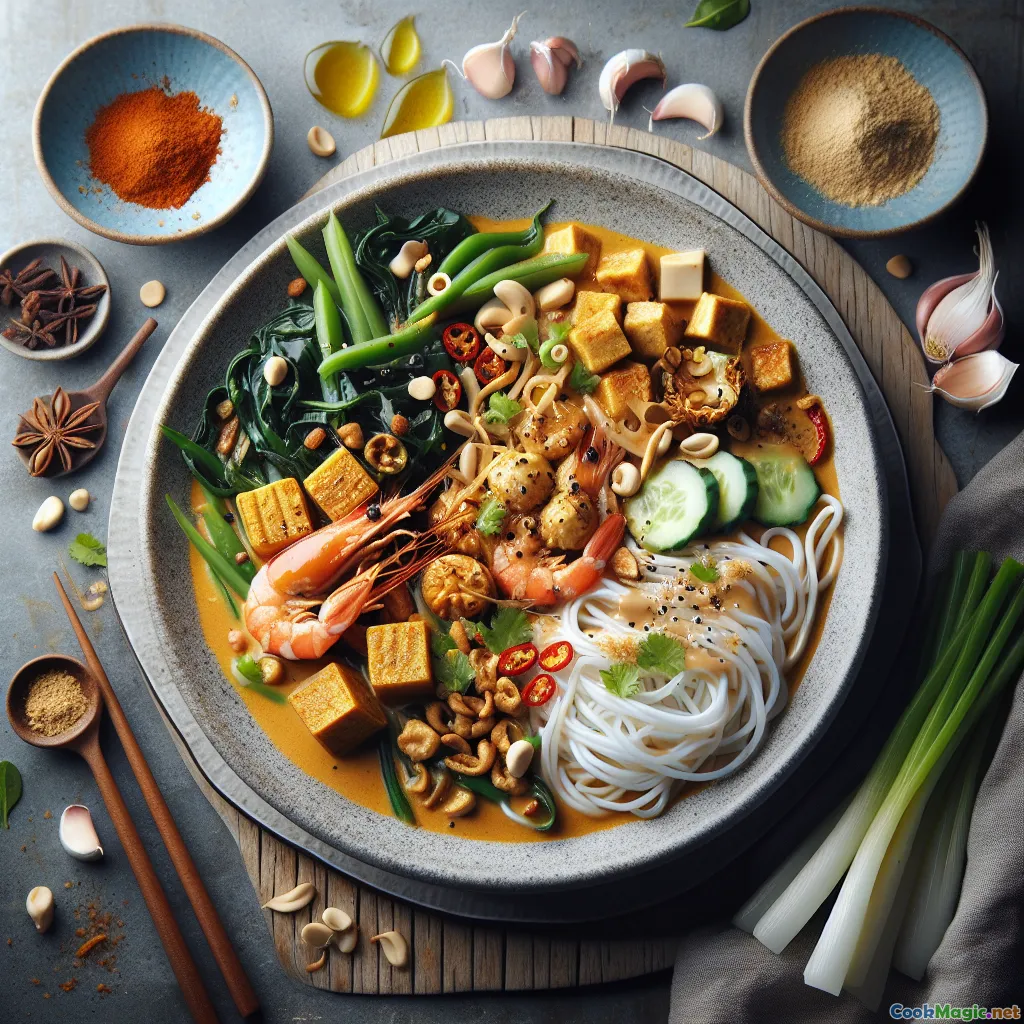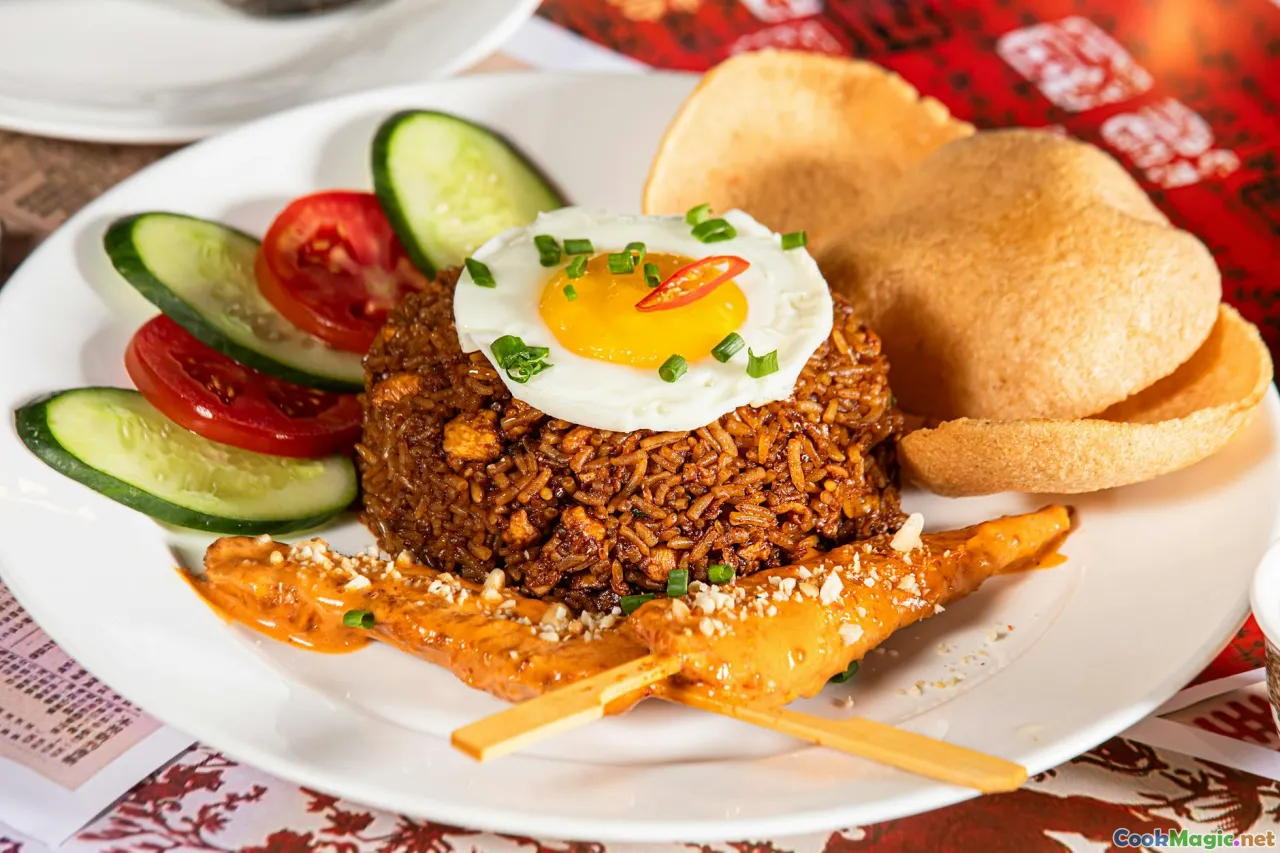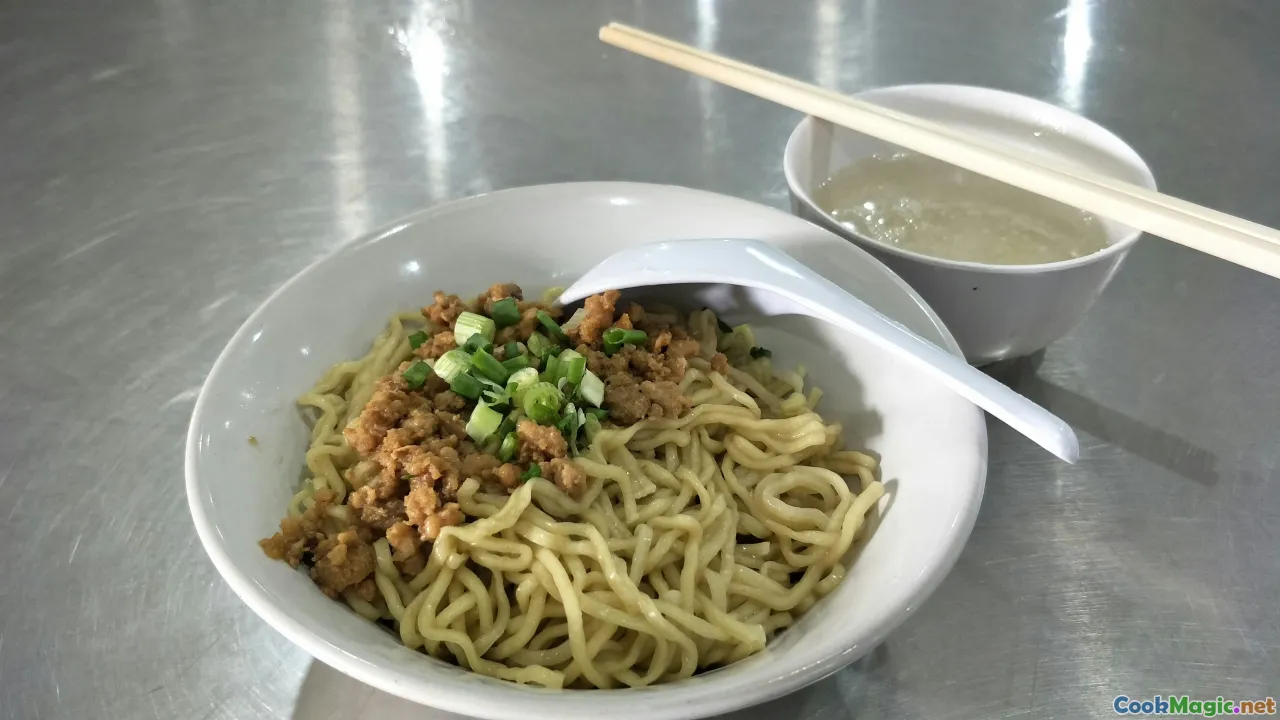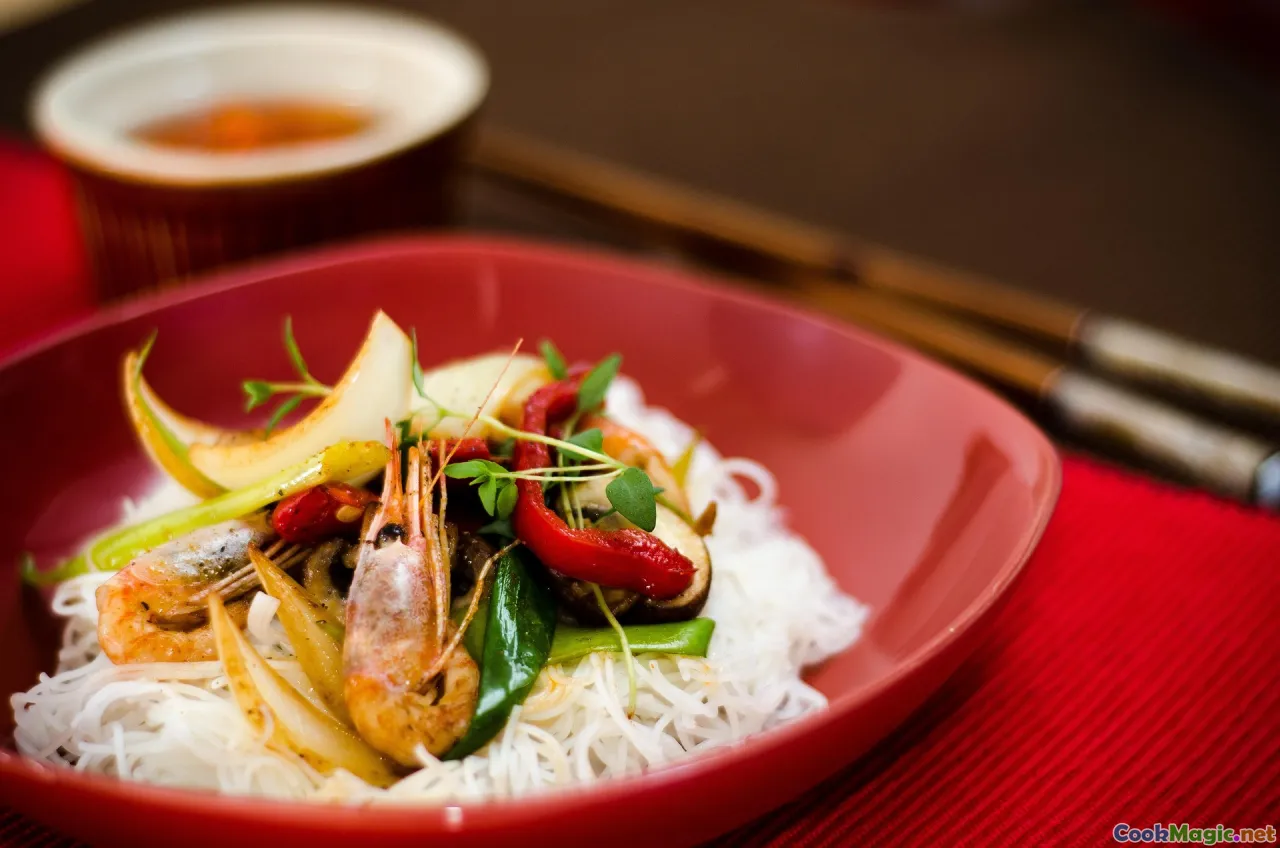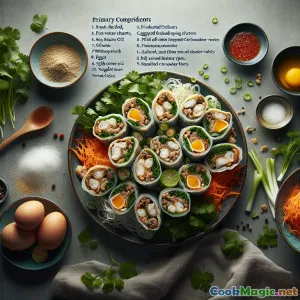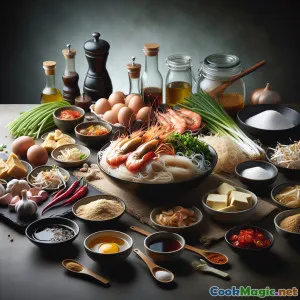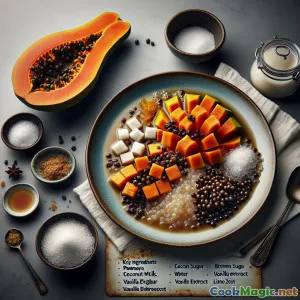
Singapur-Style Satay-Reisnudeln mit Cremiger Erdnusssoße
(Singapore-Style Satay Bee Hoon with Creamy Peanut Sauce)
(0 Bewertungen)0
172
Oktober 01, 2025
Problem melden
Zutaten
-
200 grams Reis-Vermicelli (bee hoon)
(Soak in warm water 15 mins, drain well)
-
120 grams Hähnchenbrust, dünn geschnitten
(Or substitute with shrimps, pre-boiled)
-
80 grams Fester Tofu, gewürfelt
(Pan-fried recommended)
-
75 grams Sprossen, getrimmt
(Blanched briefly)
-
70 grams Wasser-Spinat (Kang Kong), in 2-Zoll-Stücke geschnitten
(Blanched (can sub with spinach))
-
40 grams Gekochte Muscheln, gereinigt
(Optional but authentic)
-
6 medium Frische, geschälte und entdarmte Garnelen
(Blanched for 1 minute)
-
20 grams frittierte Schalotten
(Zum Garnieren)
-
30 grams Gurkenscheiben julienne
(Zum Garnieren und Frischeverleih)
-
30 grams Geröstete Erdnüsse zerdrückt
(Für zusätzliche Knusprigkeit)
-
400 ml Wasser
-
90 grams Erdnussbutter (cremig oder stückig)
(Natural preferred; or grind roasted peanuts)
-
100 ml Kokosmilch
-
20 grams Schalotten
(Fein gehackt)
-
3 cloves Knoblauch
(Gehackt)
-
1.5 tbsp Rote Chilipaste
(For heat; adjust to taste)
-
1 tsp Korianderpulver
-
1.5 tbsp Zucker
(Palm sugar or white sugar)
-
2 tbsp Sojasauce
(Light; GF version if preferred)
Salz, to taste
-
2 tbsp Öl
(Zum Sautieren)
(Soak in warm water 15 mins, drain well)
(Or substitute with shrimps, pre-boiled)
(Pan-fried recommended)
(Blanched briefly)
(Blanched (can sub with spinach))
(Optional but authentic)
(Blanched for 1 minute)
(Zum Garnieren)
(Zum Garnieren und Frischeverleih)
(Für zusätzliche Knusprigkeit)
(Natural preferred; or grind roasted peanuts)
(Fein gehackt)
(Gehackt)
(For heat; adjust to taste)
(Palm sugar or white sugar)
(Light; GF version if preferred)
(Zum Sautieren)
Nährwerte
- Portionen: 2
- Portionsgröße: 1 Teller (350g)
- Calories: 540 kcal
- Carbohydrates: 66 g
- Protein: 25 g
- Fat: 19 g
- Fiber: 7 g
- Sugar: 9 g
- Sodium: 960 mg
- Cholesterol: 95 mg
- Calcium: 110 mg
- Iron: 3 mg
Anweisungen
-
1 - Soak and Prepare the Noodles:
Soak rice vermicelli in warm water for 10-15 minutes until soft but al dente. Drain and set aside.
-
2 - Blanch and Prep Ingredients:
Blanch chicken slices, prawns, beansprouts, kang kong, and optional cockles in boiling water just until cooked. Remove and set aside each ingredient separately. Pan-fry tofu cubes if using.
-
3 - Make the Peanut Satay Gravy Base:
Heat oil in a pot over medium flame. Sauté shallots and garlic until fragrant and translucent. Add red chili paste and coriander powder, frying until aromatic.
-
4 - Add Liquids to Satay Sauce:
Add water, soy sauce, and sugar. Bring it to a gentle simmer, stirring to dissolve all sugar.
-
5 - Incorporate Peanut & Coconut:
Stir in peanut butter and coconut milk. Whisk gently to combine until a smooth, slightly thick consistency forms. Adjust seasoning with salt, and more soy sauce if desired.
-
6 - Assemble Noodle Plates:
Portion soaked vermicelli onto plates. Layer with prepared meats, tofu, beansprouts, kang kong, cockles, and prawns. Pour hot peanut satay gravy generously over.
-
7 - Garnish & Serve:
Top each plate with fried shallots, julienned cucumber, and crushed peanuts for crunch. Serve immediately while hot.
Soak rice vermicelli in warm water for 10-15 minutes until soft but al dente. Drain and set aside.
Blanch chicken slices, prawns, beansprouts, kang kong, and optional cockles in boiling water just until cooked. Remove and set aside each ingredient separately. Pan-fry tofu cubes if using.
Heat oil in a pot over medium flame. Sauté shallots and garlic until fragrant and translucent. Add red chili paste and coriander powder, frying until aromatic.
Add water, soy sauce, and sugar. Bring it to a gentle simmer, stirring to dissolve all sugar.
Stir in peanut butter and coconut milk. Whisk gently to combine until a smooth, slightly thick consistency forms. Adjust seasoning with salt, and more soy sauce if desired.
Portion soaked vermicelli onto plates. Layer with prepared meats, tofu, beansprouts, kang kong, cockles, and prawns. Pour hot peanut satay gravy generously over.
Top each plate with fried shallots, julienned cucumber, and crushed peanuts for crunch. Serve immediately while hot.
Mehr über: Singapur-Style Satay-Reisnudeln mit Cremiger Erdnusssoße
Satay Bee Hoon with Peanut Gravy: Summary, Notes, and Culture
Satay Bee Hoon with Peanut Gravy is a spellbinding fusion dish that combines aspects of savory noodle cuisine with the beloved Southeast Asian satay, rendering it utterly unique. At its core, this dish transports one to the bustling hawker centers of Singapore—its official home—where the aroma of garlicky, peanut-laden sauces meets a tide of silk-smooth rice vermicelli in unparalleled harmony. Unlike the more internationally known satay skewers, Satay Bee Hoon is distinctly a plate of noodles crowned with a profuse, spiced peanut sauce, adorned throughout with elements like blanched vegetables, sliced chicken or prawns, tofu, optional cockles, and always a dusting of crispy shallots or gritty peanut chunks.
Unique Aspects & Recipe Tips
- Peanut gravy is the star here: Choose high-quality peanut butter, or, if inclined, make your own by grinding roasted peanuts—both keep the sauce lush and charismatic. A good fare should be pourable, lusciously coating every noodle strand without being overly thick or runny.
- Ingredients are variably topped to suit all: The addition of fresh, briefly blanched greens like kang kong gives welcome color and flavor complexity, while optional shellfish, tofu, or bean sprouts add options for vegetarians or seafood lovers alike.
- Use freshly-cooked ingredients: As assembly and carrying gravy heat rapidly soften and warm the dish, ensure toppings are cooked just‘bar’to not go mushy beneath the hot satay pour.
- Balance, always: Tweaking chili, salt, and sweetness is the key; traditional recipes may edge much sweeter or have more or less heat, depending on family or regional preference. A squeeze of lime before serving gives extra lift.
History & Cultural Significance
Satay Bee Hoon is unmissably Singaporean: the flavors of Malay satay grilled meats, married with Chinese rice noodle (bee hoon) comfort, woven through an underlying glimpse of Indian and Thai influence in the sauce spice and coconut cream. Its origins point to the rich migration patterns in colonial Singapore—a tapestry woven by Chinese Teochew, Southeast Asian Malay, and Peranakan communities, who each contributed techniques and taste profiles still named today.
Traditionally a hawker center and street-corner fare eaten for lunch or dinner, the dish owes its obscurity in many kitchens to its slightly unusual marriage of land and sea proteins while also being splendorsome in family or festive gatherings for its all-in-one visual and culinary drama.
Further Tips & Variations
- Substitute kang kong with baby spinach for easier accessibility outside Asia.
- If concerned about spicy food, halve the chili paste and add gradually, or even serve chili on the side.
- Swap coconut milk with evaporated milk for a less sweet note—common in family-style adaptations.
- Vegetarians can revel by excluding cockles/prawns and using soy sauce—add mushrooms for earthy richness.
Personal Thoughts
I find Satay Bee Hoon uniquely comforting and exciting; it unites texture and sensation in a way that few noodle bowls manage. The initial mildness of the tender vermicelli quickly yields to warming tones of peanut, spice, and coconut, accented with a salty, savory nonchalance from soy sauce. With just a few minutes of prep and a rapid assembly, it can be made at home—even sparkling with garnishes from your fridge or regional market. Exploring this unique satay in the noodle world is not only delicious but an appreciation for Singapore's cultural melting pot within a single bowl.
Whether you’re longing for a plate reminiscent of Southeast Asian travel memories or aim to wow friends with a boldly flavor-forward dinner, Satay Bee Hoon is an experience I recommend time and again. Add extra cucumber and peanuts for texture, or dig into fusion by customizing proteins according to your preference—it's transformative and casually fun.
Explore, tinker, and celebrate the layered culture of Singapore right at your own table!
